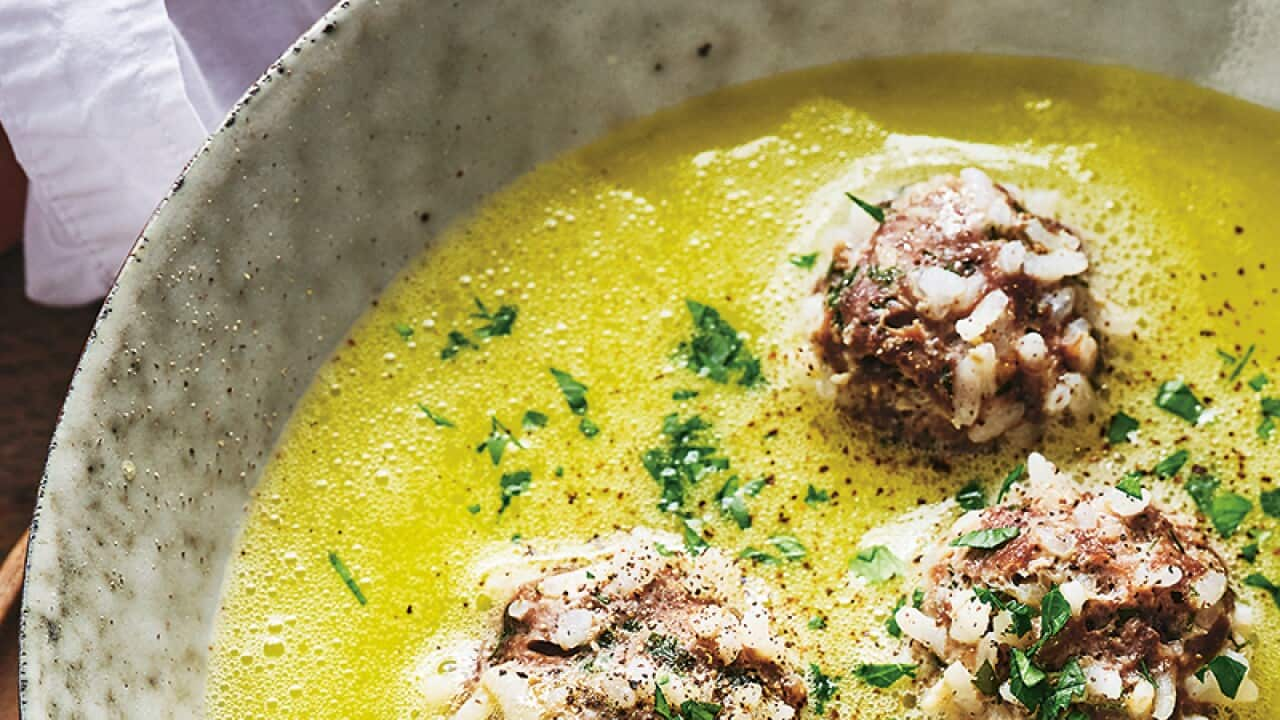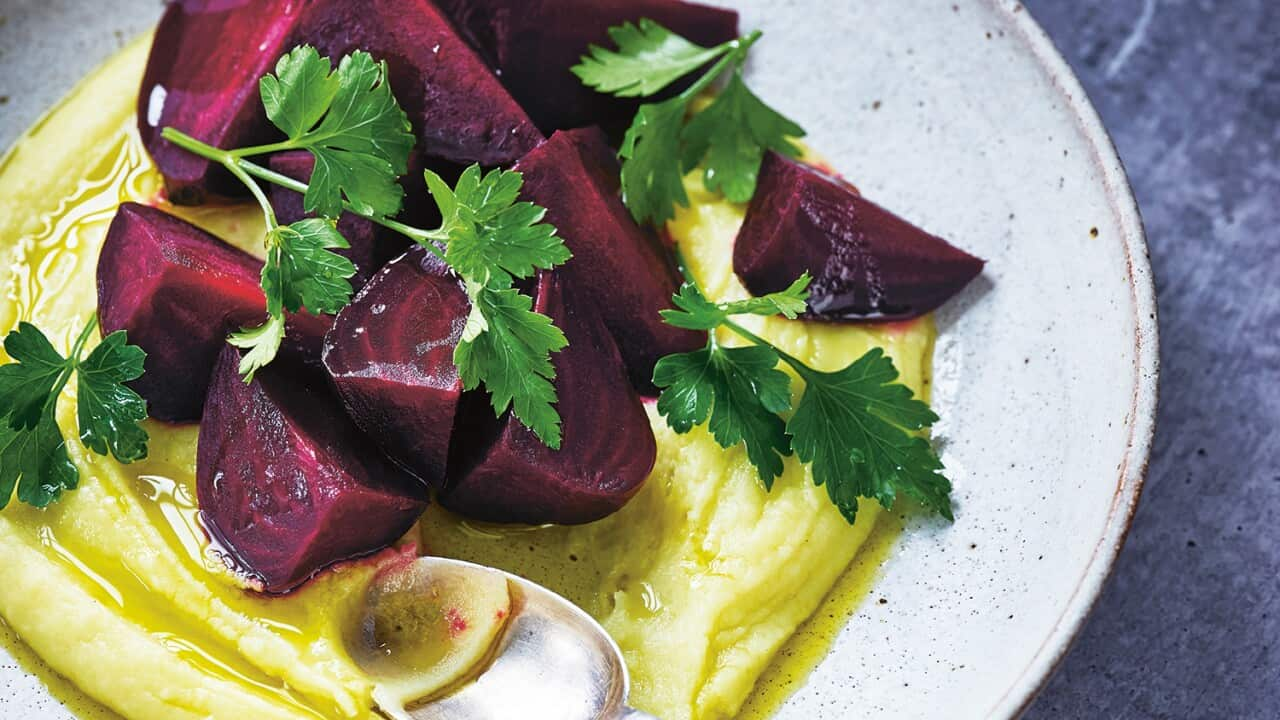--- Catch Helen Tzouganatos cooking up a gluten-free storm in double episodes every Friday from 8pm on , or stream it on . ---
Gluten-free flours generally fall into three categories:
- Neutral white flours for bulk and starch: rice flour, sweet rice flour, potato starch flour, tapioca flour and cornflour.
- Nut meals/flours for protein, moisture, vitamins and minerals: almond meal, hazelnut meal and chestnut flour.
- Wholesome flours for protein and fibre: chickpea (besan) flour, buckwheat flour, sorghum flour, teff flour, millet flour, tiger nut flour and quinoa flour.
If you suffer from additional allergies and need to substitute flours I suggest you do this within the same category. For example, if you have a rice allergy you can replace rice flour with another neutral white sticky flour such as tapioca. In the wholesome, nutrient-dense category, sorghum and buckwheat can be used interchangeably. The gluten-free flours I most commonly use are listed below.
Buckwheat
Despite the name buckwheat is a seed and does not contain any wheat. Nutritionally dense, it is high in protein, fibre, iron, zinc, selenium and B vitamins plus it can also aid digestion. Buckwheat has an earthy flavour and soft starchy texture so it’s perfect in breads and pancakes. If you want to mellow its assertive flavour, blend it with a neutral white flour, such as sweet rice or tapioca. Chickpea (besan) flour
Chickpea (besan) flour

Soba noodles are traditionally made with ground buckwheat. Source: SBS Food
Made from ground chickpeas this flour has a mild, nutty taste. It is fantastic in savoury dishes, such as , pancakes and fritters, because its sticky texture gives it great binding qualities, ideal when working sans gluten. It is high in protein, fibre, antioxidants and micronutrients, making it one of the healthiest flours you can keep in your pantry.
Cornflour
Cornflour is a fine white flour derived from ground corn kernels. It’s a great binder and has a neutral flavour so it’s extremely versatile in pastry making. Make sure you purchase a brand made from 100 per cent corn and labelled ‘gluten free’ because some brands contain wheat.
Gluten-free plain (all-purpose) flour
The quality of commercial gluten-free plain flours can vary greatly. Every manufacturer has their own unique blend, aiming to mimic regular wheat flour. Some brands bake well while others will leave you with a crumbly mess. My advice is to try a few before you settle on one you like. As a general rule you get what you pay for, with the more expensive brands delivering far superior results.

Helen uses a plain gluten-free flour for her pita recipe. Source: Jeremy Simons
Cook it

Gluten-free pita breads
Nut and seed meals
Nut meals are made from ground nuts, such as almonds, hazelnuts and pistachios. They have a slightly coarse texture and rich, nutty flavour. Nut meals are high in protein, fibre, vitamins, minerals and healthy fats, making them a great option for people following a low-carb, grain-free or paleo diet. The natural fats add incredible moistness and richness to food, quite often meaning the recipe doesn’t require added fat. For example, my simple chocolate & hazelnut cake stays wonderfully moist from hazelnut meal alone. If you have a nut allergy, seed meals, such as pumpkin or sunflower can be used as a substitute.
Tiger nut flour
Tiger nuts are not actually nuts, they are a root vegetable with a sweet, nutty flavour. Tiger nut flour is extremely versatile and can be used as a nut-free alternative to almond meal, providing moistness and a delicate sweetness to baked goods. This ground root flour is very high in dietary fibre and resistant starch so it is great for gut health. It is also a good source of iron, potassium, protein, magnesium, zinc and vitamins C and E.
Potato starch
Potato starch (or potato starch flour) is made from the dried starch component of peeled potatoes, and it adds softness and lightness to gluten-free baked goods. It is not the same as potato flour and you cannot substitute one for the other. Potato flour is made from whole potatoes, has a heavy texture and strong potato flavour. I never use it. Sorghum
Sorghum

Potato starch is what gives this karaage chicken its crispy outer. Source: SBS VICELAND
Sorghum is a nutrition powerhouse that is high in antioxidants, protein, fibre and iron, with a smooth texture and mild sweet taste. It pairs well with neutral white flours to add great flavour, texture and nutritional value to baked goods. Do note that it has a bitter profile so I generally don’t use more than 30 per cent sorghum in a flour blend.
Tapioca
The most versatile flour in the gluten-free pantry is tapioca, derived from the cassava plant native to South America. Tapioca is great for binding, thickening and crumbing, and adds great texture to baked goods. It will make your bread bouncy, your crumb light and your sauces thicker.
Xanthan gum
Xanthan gum is used as a thickening substitute in gluten-free baking. It mimics the qualities of gluten and helps baked goods rise by trapping air bubbles created by leavening agents such as baking powder and yeast. If you are sensitive to xanthan gum you can replace it with psyllium husks or ground chia seeds to add some elasticity to your recipes.
This article is an edited extract from by Helen Tzouganatos, Published by Plum, RRP $39.99, Photography by Jeremy Simons.








